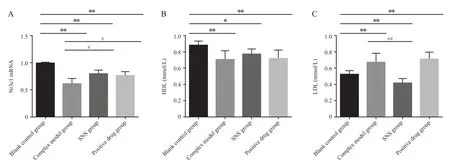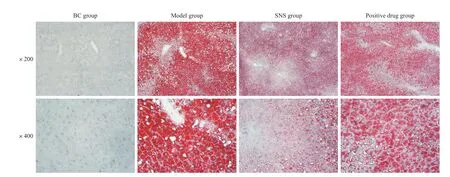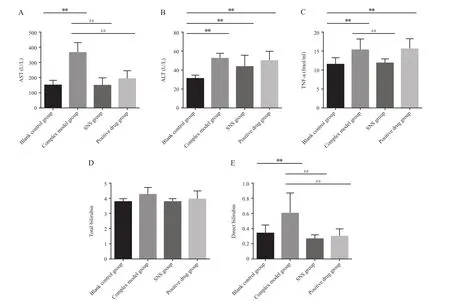Therapeutic Effects of "Soothing the Liver Method" on Stress-related Non-alcoholic Fatty Liver on Neuroendocrine-metabolic Level
Mu Jie (穆杰), Wng Xueqin (王雪茜), Wng Qingguo (王慶國), Cheng Ffeng (程發(fā)峰),Lin Yjun (連雅君), Du Xin (杜欣), Liu Shuling (劉姝玲), nd Zhng Hixi (張海霞)
a: Key Laboratory of Syndrome and Formula Basic Research by Chinese Ministry of Education and Beijing University of Chinese Medicine, Beijing 100029, China
b: Jingui Yaolue Section, Teaching and Research Department of Clinical Foundation of Chinese Medicine, School of Chinese Medicine, Beijing University of Chinese Medicine, Beijing 100029, China
ABSTRACT OBJECTIVE: To study the therapeutic effects of "soothing the liver method" on stress-related non-alcoholic fatty liver and its treatment mechanism on neuroendocrine-metabolic level. METHODS: The animal model of stress-related nonalcoholic fatty liver which is more in line with the modern social and clinical conditions was established by the method of chronic restraint compound high-fat feed. AST and ALT were detected by automatic biochemical analyzer. Serum cortisol and TNF-a were detected by radioimmunoassay. The relative expression of Nr3c1 mRNA was detected by real-time quantitative PCR. RESULTS: Compared with the blank group, the scores of open field test, Nr3c1 mRNA decreased, and AST, ALT, FFA were significantly increased in model group. Compared with model group, the open field test scores, Nr3c1 mRNA increased,and Cor, AST, FFA, LDL, TNF-a, were significantly decreased in SNS group. CONCLUSIONS: "Soothing the liver method"can exert its therapeutic effect on stress-related non-alcoholic fatty liver on neuroendocrine-metabolic level.
KEY WORDS: Non-alcoholic fatty liver disease; Chronic stress; Soothing the liver method; Sini Power
INTRODUCTION
The incidence of non-alcoholic fatty liver disease(NAFLD) is closely related with high-fat, high calorie diet1. TCM theory holds that NAFLD is caused by phlegm dampness, because -large intake of fat and greasy diet easily leads to phlegm dampness". And"fortifying the spleen and removing dampness" is the main treatment method2. However, in modern society,as work and study pressure gradually increases, chronic psychological stress, as an inducing factor, can lead to a variety of diseases3. Some studies suggest that chronic psychological stress plays a mediating role in the pathogenesis of NAFLD4. Professor Qiao Mingqi puts forward that emotional disorder caused by chronic psychological stress is a combination of a variety of emotional factors, which easily cause liver injury5. These studies suggest that modern clinical NAFLD is no longer a simple factor induced disease, which is mainly induced by chronic psychological stress complex high fat, high calorie diet. Therefore, the treatment should also focus on the application of "soothing the liver method" based on fortifying the spleen and removing dampness. This study aims to explore the therapeutic effects and treatment mechanism of "soothing the liver method" on stressrelated NAFLD on neuroendocrine-metabolic level.
MATERIALS AND METHODS
Animals
Forty-eight male adult Winstar rats (12 weeks old,weight (250±20 g) of specific pathogen free (SPF) were purchased from Beijing Vital River Laboratory Animal Technology (Beijing, China). Animal license number:SCXK-(Jing) 2012-0001. Animal quality certificate number: 11400700070260. All laboratory animals were fed in a SPF animal room, Institute of Chinese Materia Medica, China Academy of Chinese Medical Sciences.The experimental operation and animal husbandry strictly abided during the operating procedures of SPF animal laboratory. Raising conditions: 12 h light, 12 h dark, room temperature 10-25℃, relative humidity 40%-60%, no noise environment (background noise 40±10db).
Apparatus and reagents
Apparatus
Radio immunoassay analyzer (xh6080, Xi'an He Yi Chang, Xi'an, China), automatic biochemical analyzer(Toshiba, TBA-120FR, Tokyo, Japan), vortex oscillation instrument (Haimen Kylin-Bell Lab Instruments, QL-902,Nantong, China), spectrophotometer (NanoDrop 2000,Thermo Fisher Scientific, Shanghai, China), fluorescent quantitative PCR (ABI7500, applied biosystems,Waltham, Massachusetts), upright metallurgical microscope (Olympus, BX51, Japan), frozen slicing machine (Leica in CM1510S, Brunswick, Germany).
Reagents
Kit: I-125 cortisol radioimmunoassay kit (S10940097,Beijing North Institute of Biotechnology, Beijing, China),tumor necrosis factor radioimmunoassay kit (Beijing North Institute of Biotechnology, Beijing, China).
RT-PCR related reagents: Real time PCR primers were from Invitrogen (Carlsbad, California). TRNzol extraction reagent for the total RNA was from Tiangen Biotech (Beijing) (Beijing, China). PrimeScript? RT reagent Kit with gDNA Eraser (RR047B), SYBR?Premix Ex Taq? II (Tli RNaseH Plus), ROX plus(RR82LR), and DL2,000 DNA Marker (3427Q) were all purchased from TaKaPa (Dalian, China).
Grouping, modeling and drug administration
Grouping: According to the scores in open- field test,rats with abnormal score were excluded. The included rats were randomly divided into blank control group (BC group), complex model group (model group), Sini Power group (SNS group), and positive drug group.
Modeling: model group, SNS group and positive administration group were tied for 6 hours, and fed with self-prepared high fat diet (25% lard oil, 2% cholesterol, 2%salt, 5% sugar, 66% basal feed) for 8 consecutive weeks.
Drug administration: SNS group received intragastric administration of Sini Power (Radix Bupleuri 10g, fried Fructus Aurantii Immaturus 10g, Radix Paeoniae Alba 10g, Radix et Rhizoma Glycyrrhizae Praeparata cum Melle 10g, decocted with water for twice, 1h once, remove residue, two decoctions were concentrated to 2g crude drugs in every 1mL decoction, store in 4℃ refrigerator,and dilute with deionized water) from fourth week. Dose for rats was calculated according to dose for human body,with gavage volume of 1mL / kg. Positive drug group received intragastric administration of Xuezhikang (Beijing Beida Weixin Biotechnology Co. Ltd., Beijing, China,SFDA approval number: Z10950029). Dose for rats was calculated according to dose for human body, with gavage volume of 1mL / kg, and it was dissolved in deionized water when administered.
Methods
General condition observation
The body weight, open- field test scores were measured 1d before experiment, week 4 and week 8 after experiment.
Serum biochemistry and hormone detection
The automatic biochemical analyzer was used to detect serum samples of all groups. Rat TNF-a and cortisol were tested in strict accordance with kit instructions.
RT-PCR test
RNA was extracted using TRNzol total RNA extraction reagent, and RNA concentration and purity were determined by NanoDrop? ND-2000, denatured by agarose gel electrophoresis. cDNA reverse transcription was performed by PrimeScript? RT reagent Kit with gDNA Eraser, and the purpose of each sample Realtime PCR was performed on genes and internal controls,respectively. The data were analyzed by 2-△△CT method.Primer sequences were shown in Table 1.
Liver pathology detection and evaluation
After removal of the liver tissue, paraffin embedding was conducted in paraformaldehyde (4% paraformaldehyde)and stained with HE, mounting and photographed. The liver tissue was taken out and wrapped in tinfoil, and frozen in dry ice. Then it was sliced by frozen slicing machine, and part of frozen section of liver tissue was stained with oil red O.
Statistical analysis
The SPSS 15.0 was used to conduct one-way analysis of variance (ANOVA), and P<0.05 is considered to be of statistical difference, and the results were expressed as mean ± SD.

Table 1. Primer sequence

Table 2. Rat's body weight in various groups at week 0, week 4, and week 8 (g, n=8, mean±SD)

Table 3. Rat's open- field test scores in various groups at week 0, week 4, and week 8 (n=8, mean±SD)

Table 4. The relative expression of Nr3c1 mRNA in the cortisol receptors of all groups (n=3, mean±SD)

Table 5. Serum cortisol level of all groups (ng/ml, n=8, mean±SD)
RESULTS
General observation
Compared with BC group, the open-field test scores of other three groups at week 4 and week 8 were significantly decreased (P<0.01), and the score in SNS group was significantly increased compared with that of model group (P<0.05). The differences in weight were not significant among groups.
Evaluation on HPA axis at neuroendocrine level
As shown in Table 4 and Table 5, compared with BC group, the relative expression of Nr3c1 mRNA in the cortisol receptors of the other three groups was significantly decreased (P<0.01), and that of the model group was significantly increased (P<0.05). Compared with model group, the relative expression of Nr3c1 mRNA in hippocampus of rats in SNS group and positive drug group was significantly increased (P<0.05), and serum cortisol level was significantly decreased (P<0.01).

Figure 1. Rat's body weight and open- field test scores comparison at week 0, 4, and 8 among groups

Table 6. Contents of serum FFA, HDL, LDL (mmol/L, n=8, mean±SD)

Figure 2. Evaluation on HPA axis at neuroendocrine level

Figure 3. Lipid metabolism evaluation

Figure 4. Oil red O staining frozen section of liver tissue of all groups

Figure 5. Contents of serum AST, ALT, TNF-a, Tbil and Dbil
Lipid metabolism evaluation
As shown in Table 6, compared with BC group,the levels of serum FFA and LDL in model group were significantly increased and HDL was significantly decreased(P<0.01). After Sini Power, Xuezhikang treatment for 4 weeks, serum FFA was significantly lower (P<0.01), and LDL of SNS group was significantly decreased (P<0.05).
Liver injury and in flammation evaluation
As shown in Table 7, the levels of AST, ALT, TNF-a and Dbil in model group were significantly higher than those in BC group (P<0.01). After treatment with Sini Power and Xuezhikang for 4 weeks, AST and Dbil were significantly decreased (P<0.01), and TNF-a in SNS group decreased significantly (P<0.01).
DISCUSSION
In this study, the animal model of stress-related NAFLD which was more in line with the modern social and clinical conditions6was established by the method of chronic restraint compound high-fat feeding that simulated modern society life style of high fat and high calorie1. Sini san, from Treatise on Febrile Diseases, isrepresentative formula of "soothing the liver method"7.Positive drug of Xuezhikang Capsule has certain therapeutic effect on hyperlipidemia and NAFLD, whose main ingredient is red rice with actions of fortifying the spleen, resolving dampness and promoting digestion8.

Table 7. Contents of serum AST, ALT, TNF-a, Tbil and Dbil (n=8, mean±SD)
Depression and anxiety caused by chronic psychological stress were evaluated by open-field test scores. Sini Power can significantly increase the openfield test scores. The neuroendocrine level evaluation mainly lies in the level of the HPA axis, and chronic psychological stress can damage the HPA axis high central hippocampus cortisol receptors9, so that the loss of regulation of cortisol secretion results in high level of cortisol10. Sini Power could restore HPA axis functional status, and make neuroendocrine return to normal functional status. At the metabolic level, FFA, HLD, LDL and FFA are important reference indexes for abnormal lipid metabolism11, and FFA can lead to NAFLD through directly forming lipid toxicity12, resulting in mitochondrial damage to increase oxidative stress12, which is one of the serum-specific indicators of the prevalence of NAFLD13.Decreased HDL and increased LDL are both risk factors for the pathogenesis of NAFLD14. Sini Power can significantly reduce FFA and LDL, which has a trend in improving HDL. The liver injury was evaluated by AST,ALT, Tbil and Dbil, and the in flammatory response was evaluated by TNF-a. The intrahepatic lipid storage was observed by oil red O staining, and the results showed that Sini Power can significantly improve liver injury,in flammation response and liver lipid storage.
Chronic psychological stress can interfere with neuroendocrine level and thus affect lipid metabolism4,leading to the pathogenesis of NAFLD. Therefore, the TCM clinical treatment of stress-related non-alcoholic fatty liver disease that proposed by modern social environment and clinical practice cannot be simply limited to fortifying the spleen and removing dampness,and enough attention should be given to soothing the liver method.
 World Journal of Integrated Traditional and Western Medicine2018年1期
World Journal of Integrated Traditional and Western Medicine2018年1期
- World Journal of Integrated Traditional and Western Medicine的其它文章
- A Systematic Review and Meta-Analysis of Herb-Partitioned Moxibustion in the Treatment of Primary Dysmenorrhea
- A Life System Tuning Model
- Probing the Definition of Yin and Yang in Our Body
- Analysis on the Pharmacists Intervention Results of the Problems from 2000 Prescriptions of Chinese Herbal Pieces
- Systematic Review and Meta-Analysis of Randomized Controlled Trials of Xianling Gubao Capsule as Adjuvant Treatment of Osteoporotic Fracture
- New Year's Message
